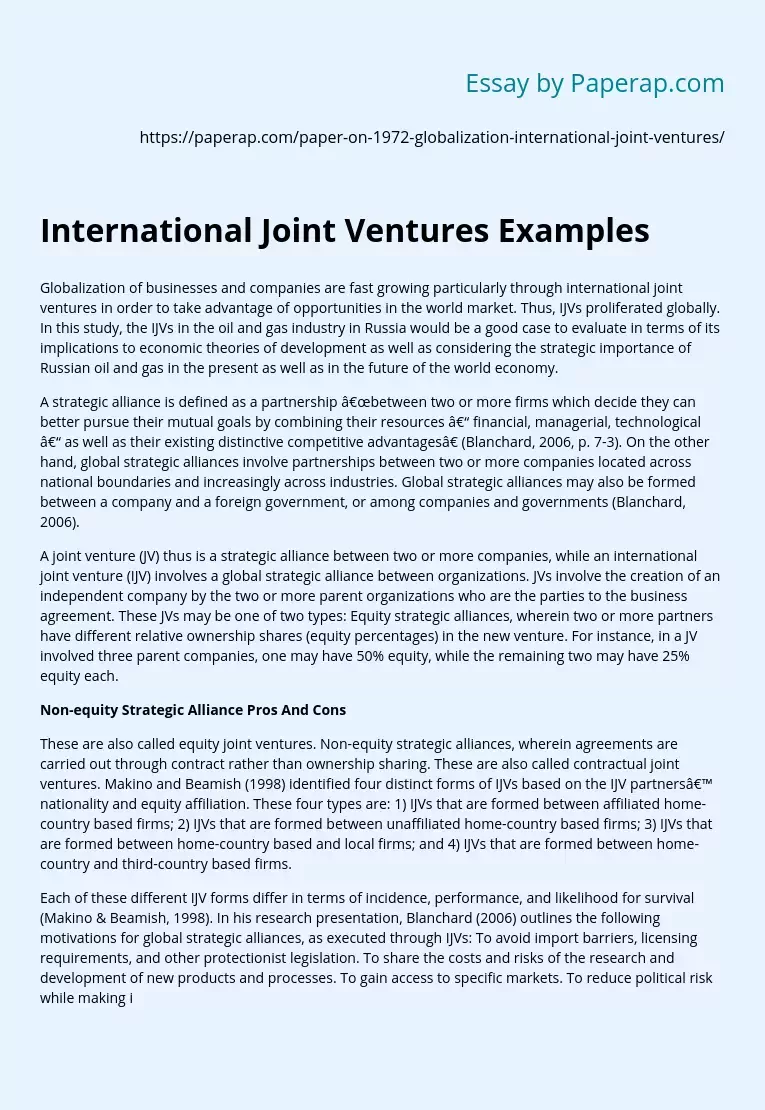International Joint Ventures Examples
Globalization of businesses and companies are fast growing particularly through international joint ventures in order to take advantage of opportunities in the world market. Thus, IJVs proliferated globally. In this study, the IJVs in the oil and gas industry in Russia would be a good case to evaluate in terms of its implications to economic theories of development as well as considering the strategic importance of Russian oil and gas in the present as well as in the future of the world economy.
A strategic alliance is defined as a partnership “between two or more firms which decide they can better pursue their mutual goals by combining their resources – financial, managerial, technological – as well as their existing distinctive competitive advantages” (Blanchard, 2006, p. 7-3). On the other hand, global strategic alliances involve partnerships between two or more companies located across national boundaries and increasingly across industries. Global strategic alliances may also be formed between a company and a foreign government, or among companies and governments (Blanchard, 2006).
A joint venture (JV) thus is a strategic alliance between two or more companies, while an international joint venture (IJV) involves a global strategic alliance between organizations. JVs involve the creation of an independent company by the two or more parent organizations who are the parties to the business agreement. These JVs may be one of two types: Equity strategic alliances, wherein two or more partners have different relative ownership shares (equity percentages) in the new venture. For instance, in a JV involved three parent companies, one may have 50% equity, while the remaining two may have 25% equity each.
Non-equity Strategic Alliance Pros And Cons
These are also called equity joint ventures. Non-equity strategic alliances, wherein agreements are carried out through contract rather than ownership sharing. These are also called contractual joint ventures. Makino and Beamish (1998) identified four distinct forms of IJVs based on the IJV partners’ nationality and equity affiliation. These four types are: 1) IJVs that are formed between affiliated home-country based firms; 2) IJVs that are formed between unaffiliated home-country based firms; 3) IJVs that are formed between home-country based and local firms; and 4) IJVs that are formed between home-country and third-country based firms.
Each of these different IJV forms differ in terms of incidence, performance, and likelihood for survival (Makino & Beamish, 1998). In his research presentation, Blanchard (2006) outlines the following motivations for global strategic alliances, as executed through IJVs: To avoid import barriers, licensing requirements, and other protectionist legislation. To share the costs and risks of the research and development of new products and processes. To gain access to specific markets. To reduce political risk while making inroads into a new market.
To gain rapid entry into a new or consolidating industry and to take advantage of synergies. Blanchard (2006) presents four significant challenges in implementing global alliances. First, while alliances present a faster and less risky route to globalization, in a highly competitive environment however, it is extremely complex to fashion out global linkages especially where many interconnecting systems are involved. These interconnecting systems form intricate networks, and many alliances fail or end up in a takeover in which one partner swallows the other.
Second, usually the form of governance chosen for multinational firm alliances greatly influences their success, particularly in technologically-intense fields such as computers, pharmaceuticals, and semiconductors. Cross-border partnerships often become a sort of “race to learn” wherein the faster learner later ends up dominating the alliance and practically rewriting its terms. In a real sense, an alliance may actually emerge as a new form of competition between the parent organizations involved (Blanchard, 2006).
Third, cross-border allies often encounter difficulty in collaborating effectively, especially in competitively sensitive areas. This breeds mistrust and secrecy, which undermines the very purpose of the alliance. The difficulty that these organizations deal with is the dual nature of strategic alliances – the benefits of cooperation versus the dangers of introducing new competition through sharing their knowledge and technological skills about their mutual product or manufacturing process (Blanchard, 2006).
International Joint Ventures Examples. (2019, Dec 05). Retrieved from https://paperap.com/paper-on-1972-globalization-international-joint-ventures/

